Who's Living in the Guano?
Mites that Live in the Bat Guano of Carlsbad Cavern.
Investigation by Diana Northup and Cal Welbourn.
Project description by J. Mickey Ide, Spring 2005.
|
Mexican Free-tailed bats are the primary guano producing bats in the
United States. These bats live in caves in the western and southwestern
U.S., Mexico, Central America, the West Indies, Argentina, and central
Chile.
These bats make up the largest colony of mammals in the world and are
one of the most abundant mammals in the U.S.
The largest colony is north of San Antonio, Texas in Bracken Cave. The
Bracken Cave colony is estimated to have almost 20 million bats.
|

A Mexican Free-tailed Bat. Photo courtesy of Texas
Parks & Wildlife Department.
|
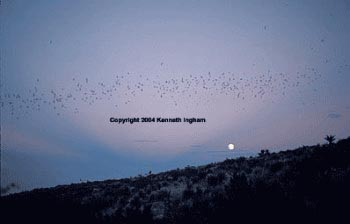
Bat flight at sunset.
|
In Carlsbad Caverns, there is a large population of Mexican Free-tailed
bats and cave Swallow birds. The bat cave section of the caverns acts as
a maternity roost for some 250,000+ migratory Mexican Free-tailed bats
(some estimates are as high as one million bats).
|
|
Both the bats and the Swallows produce waste, or guano, that is home to
many critters, including mites. These mites have not been intensively
studied even though they have the largest number of dwellers in the
guano.
Diana Northup and Cal Welbourn were curious about the inhabitants of the
guano in Carlsbad , so they undertook an investigation to see just who
was living in the guano.
|
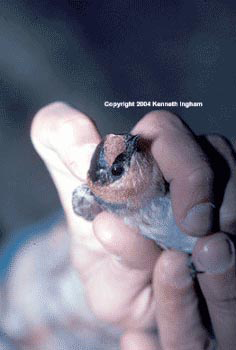
A cave swallow bird.
|
|
Northup and Welbourn went to Carlsbad Cavern to study the critters
living in the guano from the Mexican Free-tailed and cave Swallows. They
picked three sites within Carlsbad to take random samples of the guano.
They include:
(1) a swallow's roost, (2) a migratory bat's roost and (3) a nursery
bat's roost.
|

White arrow indicates example of site 1.
|
A swallow's roost is a twilight zone where cave Swallows live and sleep
during certain times of the year.
|
|
A migratory bat's roosting area is dark and is only occupied during
certain times of the year, namely summer and early fall.
|
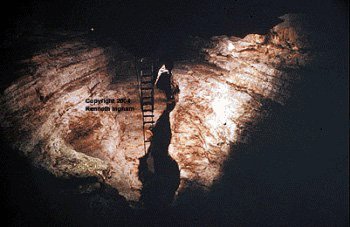
Example of site 2.
|
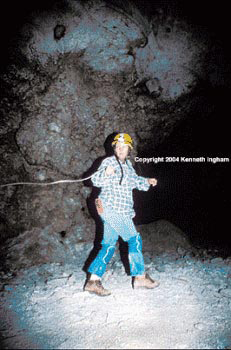
Diana Northup surveying site 3.
|
A nursery roost is where bats live to bear and raise their pups, or
young. Mexican Free-tailed pups fly 5 weeks after they are born. The
mothers nurse them in the roost until the pups can catch their own food.
|
The objectives of the research were to:
- Identify the invertebrate critters living in the Mexican Free-tailed
bat's guano in Carlsbad Caverns.
- Find seasonal changes in the number of mites or other critters
living in the guano.
- See if the number of critters changes over the course of one
year.
Results found large numbers of various mites living in the guano. These
mites include eight different types of fungivores (mites that eat fungi)
and four different types of predators (mites that eat other
critters?)Rhagidid mite. Other critters found in the guano include
fleas, flea larvae, wasps, flies, and psuedoscorpions.
The number of invertebrates found in each sample (sample size of one cup
of guano) varied from as little as 18 critters to over 10,000. This
difference depended on the time of year the sample was taken and was
mostly due to the number of bats present at the time.
|
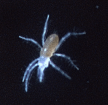
Rhagidid mite. Example of a mite found in the guano
of Carlsbad. Photo by Kenneth Ingham.
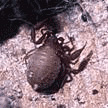
Psudeoscorpion on guano. Photo by Kenneth Ingham.
|
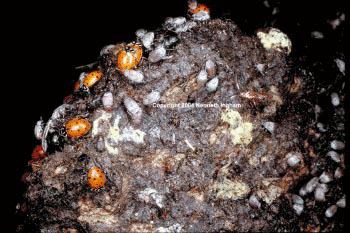
Example of a guano community in a twilight zone.
|
Northup and Welbourn discovered a few initial patterns; one was that the
number of mites and critters were highest when the bats and swallows
were present in the sample sites. This is not surprising; however, the
difference in the amount of critters present was surprising.
|
|
Another pattern was that different mites had varying numbers in
different types of guano. For example, in fresh guano one type of mite
(Rosensteiniidae) had high numbers while other mites' numbers decreased
drastically. Northup writes, "what this means is unclear."
Northup and Welbourn continue to research and study the mites living in
the Mexican Free-tailed bat's guano.
|
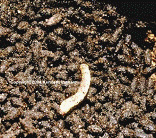
Guano moth larvae on guano.
|









